
(a)
Interpretation:
Among the given pair of compounds, which compound has the polar pi bond that will undergo nucleophilic addition more rapidly is to be identified and explained.
Concept introduction:
A Nucleophilic addition reaction involves a polar
Answer to Problem 17.34P
Among the given pair of compounds, the second compound has the polar pi bond that will undergo nucleophilic addition more rapidly than the first one. This is because with fewer alkyl groups attached to the carbonyl carbon, there is less bulkiness and greater concentration of positive charge.
Explanation of Solution
The given pair of compounds are
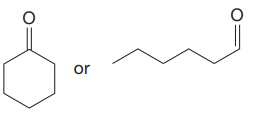
The electron-donating groups attached to the carbonyl carbon will decrease the concentration of the positive charge on the carbonyl carbon atom. In the first compound, the carbonyl carbon has two electron-donating substituents attached. In the second compound, the carbonyl carbon has only one electron-donating substituent attached. The partial positive charge on the carbonyl carbon of the second compound is greater as compared to the first one. This makes the carbonyl carbon of the second compound more electrophilic, thus, it will have more polar pi bond. Due to this, it will undergo nucleophilic addition reactions more rapidly. Due to fewer alkyl groups attached in the second compound, there is less bulkiness and hence greater contribution of a positive charge.
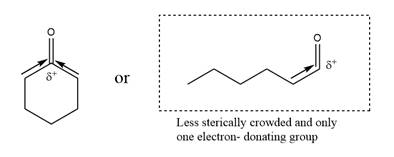
Electron-donating groups directly attached to the carbonyl carbon will decrease the concentration of a partial positive charge and make the pi bond less polar.
(b)
Interpretation:
Among the given pair of compounds, which compound has the polar pi bond that will undergo nucleophilic addition more rapidly is to be identified and explained.
Concept introduction:
A Nucleophilic addition reaction involves a polar
Answer to Problem 17.34P
Among the given pair of compounds, the second one has a more polar pi bond that will undergo nucleophilic addition more rapidly than the first one. This is because a substituent -
Explanation of Solution
The given pair of compounds are
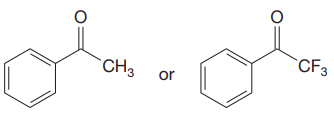
The electron-withdrawing groups attached to the carbonyl carbon will increase the concentration of the positive charge on the carbonyl carbon atom. In the first compound, the carbonyl carbon has a benzene ring at one end, and a
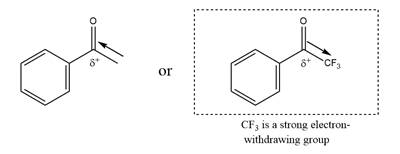
Electron-withdrawing groups directly attached to the carbonyl carbon will induce a greater concentration of a partial positive charge and make the pi bond more polar.
(c)
Interpretation:
Among the given pair of compounds, which compound has the polar pi bond that will undergo nucleophilic addition more rapidly is to be identified and explained.
Concept introduction:
A Nucleophilic addition reaction involves a polar
The concentration of the positive charge on the carbonyl carbon increases as the distance between an electron-withdrawing atom or group and the carbonyl carbon decreases.
Answer to Problem 17.34P
Among the given pair of compounds, the first one has more polar pi bond that will undergo nucleophilic addition more rapidly than the second one. This is because with the chlorine atom closer to the carbonyl carbon, the carbonyl carbon will bear a greater concentration of positive charge.
Explanation of Solution
The given pair of compounds are
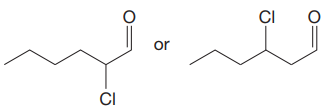
Among the given pair of compounds, the first one has more polar pi bond that will undergo nucleophilic addition more rapidly than the second one. This is because with the chlorine atom closer to the carbonyl carbon, the carbonyl carbon bears a greater concentration of positive charge. The partial positive charge on the carbonyl carbon of the first compound is greater as compared to the second one. This makes the carbonyl carbon of the first compound more electrophilic, thus, it will have more polar pi bond. Due to this, it will undergo nucleophilic addition reactions more rapidly.
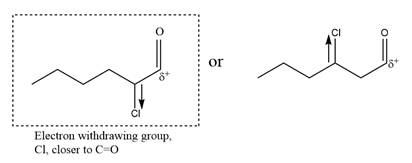
The concentration of the positive charge on the carbonyl carbon increases as the distance between an electron-withdrawing atom or group and the carbonyl carbon decreases.
(d)
Interpretation:
Among the given pair of compounds, which compound has the polar pi bond that will undergo nucleophilic addition more rapidly is to be identified and explained.
Concept introduction:
A Nucleophilic addition reaction involves a polar
Explanation of Solution
The given pair of compounds are:
![]()
Among the given pair of compounds, the first one has more polar pi bond that will undergo nucleophilic addition more rapidly than the second one. This is because the nitrile carbon bears a higher concentration of positive charge owing to the presence of the electron-withdrawing


Electron-withdrawing groups directly attached to the pi bond will induce a greater concentration of a partial positive charge and makes the pi bond more polar.
[DK1]
Want to see more full solutions like this?
Chapter 17 Solutions
EBK ORGANIC CHEMISTRY: PRINCIPLES AND M
- Calculate the pH and the pOH of each of the following solutions at 25 °C for which the substances ionize completely: (a) 0.000259 M HClO4arrow_forwardWhat is the pH of a 1.0 L buffer made with 0.300 mol of HF (Ka = 6.8 × 10⁻⁴) and 0.200 mol of NaF to which 0.160 mol of NaOH were added?arrow_forwardDetermine if the following salt is neutral, acidic or basic. If acidic or basic, write the appropriate equilibrium equation for the acid or base that exists when the salt is dissolved in aqueous solution. If neutral, simply write only NR. Be sure to include the proper phases for all species within the reaction. NaN₃arrow_forward
- A. Draw the structure of each of the following alcohols. Then draw and name the product you would expect to produce by the oxidation of each. a. 4-Methyl-2-heptanol b. 3,4-Dimethyl-1-pentanol c. 4-Ethyl-2-heptanol d. 5,7-Dichloro-3-heptanolarrow_forwardWhat is the pH of a 1.0 L buffer made with 0.300 mol of HF (Ka = 6.8 × 10⁻⁴) and 0.200 mol of NaF to which 0.160 mol of NaOH were added?arrow_forwardCan I please get help with this.arrow_forward
- Determine if the following salt is neutral, acidic or basic. If acidic or basic, write the appropriate equilibrium equation for the acid or base that exists when the salt is dissolved in aqueous solution. If neutral, simply write only NR. Be sure to include the proper phases for all species within the reaction. N₂H₅ClO₄arrow_forwardPlease help me with identifying these.arrow_forwardCan I please get help with this?arrow_forward
 Organic Chemistry: A Guided InquiryChemistryISBN:9780618974122Author:Andrei StraumanisPublisher:Cengage Learning
Organic Chemistry: A Guided InquiryChemistryISBN:9780618974122Author:Andrei StraumanisPublisher:Cengage Learning
 Chemistry for Today: General, Organic, and Bioche...ChemistryISBN:9781305960060Author:Spencer L. Seager, Michael R. Slabaugh, Maren S. HansenPublisher:Cengage Learning
Chemistry for Today: General, Organic, and Bioche...ChemistryISBN:9781305960060Author:Spencer L. Seager, Michael R. Slabaugh, Maren S. HansenPublisher:Cengage Learning


